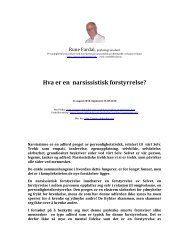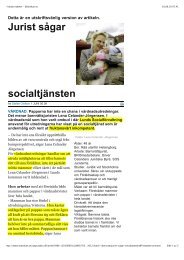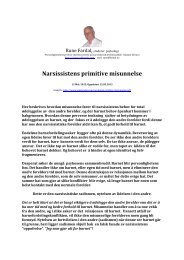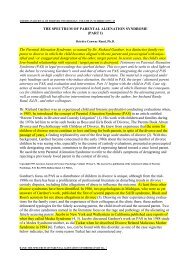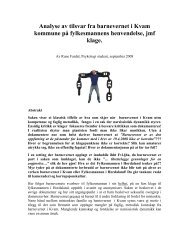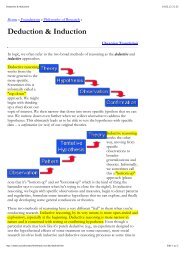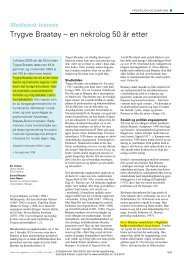The origins of narcissism and narcissistic personality disorder a
The origins of narcissism and narcissistic personality disorder a
The origins of narcissism and narcissistic personality disorder a
Create successful ePaper yourself
Turn your PDF publications into a flip-book with our unique Google optimized e-Paper software.
THE ORlGINS OF NARCISSISM 109<br />
Vygotsky, L. (1986). Thought <strong>and</strong> language (A. Kozulin, Trans.). Cambridge,<br />
MA: MIT Press. (Original work published 1934)<br />
Watson, J. S. (1979). Perception <strong>of</strong> contingency as a determinant <strong>of</strong> social<br />
responsiveness. In E. Thomas (Ed.), <strong>The</strong> origirls <strong>of</strong> social responsiveness (pp.<br />
33-64). Hillsdale, NJ: Erlbaum.<br />
Watson, J. S. (1985). Contingency perception in early social development. In<br />
T. M . Field & N. A. Fox (Eds.), Social perception in infants (pp. 157-176).<br />
Norwood, NJ: Ablex.<br />
Werner, H. (1948). Comparative psychology <strong>of</strong> mental development. New York:<br />
International Universities Press.<br />
Westen, D. (1989). Are "primitive" object relations really preoedipal? American<br />
Journal <strong>of</strong> Orthopsychiatry, 59, 331-345.<br />
Westen, D. (1990a). <strong>The</strong> relations among <strong>narcissism</strong>, egocentrism, self-concept,<br />
<strong>and</strong> self-esteem: Experimental, clinical, <strong>and</strong> theoretical considerations. Psychoanalysis<br />
<strong>and</strong> Contemporary Thought, 13, 183-239.<br />
Westen, D. (1990b). Towards a revised theory <strong>of</strong> borderline object relations:<br />
Contributions from empirical research. International Journal <strong>of</strong> Psycho-<br />
Analysis, 72, 661-693.<br />
Westen, D. (1991). Social cognition <strong>and</strong> object relations. Psychological Bulletin,<br />
109, 429-455.<br />
Wilson, A. (1985). Boundary disturbances in borderline <strong>and</strong> psychotic states.<br />
Journal <strong>of</strong> Personality Assessment, 49, 346-355.<br />
Wink, P. (1991). Two faces <strong>of</strong> <strong>narcissism</strong>. Journal <strong>of</strong> Personality <strong>and</strong> Social Psychology,<br />
62, 590-597.<br />
Wink, P., & Gough, H. G. (1990). New <strong>narcissism</strong> scales for the California<br />
Psychological Inventory <strong>and</strong> the MMPI. Journal <strong>of</strong> Personality Assessment,<br />
54, 446-463.<br />
Winnicott, D. W. (1953). Transitional objects <strong>and</strong> transitional phenomena: A<br />
study <strong>of</strong> the first not-me possession. International Journal <strong>of</strong> Psycho-Analysis,<br />
34, 89-97.<br />
Winnicott, D. W. (1958). Collected papers: Through paediatrics to psychoanalysis.<br />
New York: Basic.<br />
Winnicott, D. W. (1960). <strong>The</strong> theory <strong>of</strong> the parent-infant relationship. International<br />
Journal <strong>of</strong> Psycho-Analysis, 41, 585-595.<br />
Winnicott, D. W. (1965). <strong>The</strong> maturational processes <strong>and</strong> the facilitating environment:<br />
Studies in the theory <strong>of</strong> emotional development. New York: International<br />
Universities Press.<br />
Winnicott, D. W. (1982). Playing <strong>and</strong> reality. New York: Tavistock. (Original<br />
work published 1971)<br />
Wurmser, L. (1981). <strong>The</strong> mask <strong>of</strong> shame. Baltimore, MD: Johns Hopkins University<br />
Press.<br />
Wurmser, L. (1987). Shame: <strong>The</strong> veiled companion <strong>of</strong> <strong>narcissism</strong>. In D. L.<br />
Nathanson (Ed.), <strong>The</strong> many faces <strong>of</strong> shame (pp. 64-92). New York: Guilford<br />
Press.




